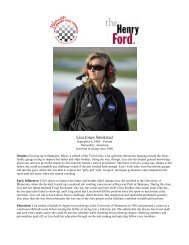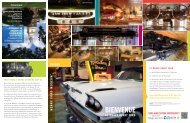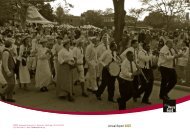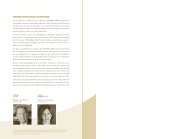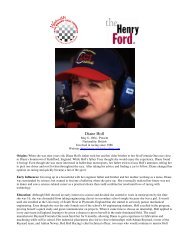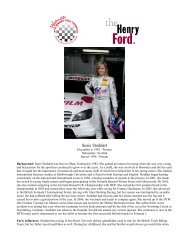Brigitte Castaing Addimando - The Henry Ford
Brigitte Castaing Addimando - The Henry Ford
Brigitte Castaing Addimando - The Henry Ford
You also want an ePaper? Increase the reach of your titles
YUMPU automatically turns print PDFs into web optimized ePapers that Google loves.
one of her professors after her sophomore year about starting an intercollegiate association for engineering students interested<br />
in racing, where groups from various schools could buy stock cars, fine tune them, and practice racing them to get more<br />
hands-on experience. Students at other schools expressed similar interest in forming such a group. <strong>The</strong> association became<br />
known as ICAR (Intercollegiate Auto Racing Association) and <strong>Brigitte</strong> participated in it during both her junior and senior<br />
years. Like Formula SAE, it only helped to augment her love of engineering and urged her forward in her career goals.<br />
Education: <strong>Brigitte</strong> spent all four years of her undergraduate career studying mechanical engineering at Duke University.<br />
Although she was involved in a number of activities, it did not hurt her studies, as she repeatedly found herself on the honor<br />
roll. After graduating in 1999, she immediately enrolled in a graduate program at MIT and received her Master's degree in<br />
mechanical engineering just sixteen months later. She wrote her thesis about fuel efficiency with regard to engines and<br />
determined that for a minimal cost, a person could use a device to check what stroke of the engine a car was on when it was<br />
initially turned on. <strong>The</strong> device would reduce the need to immediately pour in large amounts of fuel to determine the stroke,<br />
thereby reducing the amount of exhaust. In addition to her undergraduate and graduate degrees, <strong>Brigitte</strong> also took two classes<br />
at MoTech, a mechanical trade school that allows students to become state certified mechanics. Of the students in attendance<br />
the year <strong>Brigitte</strong> enrolled, only two others were women, while the remaining fifty-eight were men. After working for a few<br />
years, <strong>Brigitte</strong> eventually returned to school and added to her already impressive resume by earning an M.B.A. degree from<br />
Harvard Business School in 2005.<br />
Career Path: <strong>Brigitte</strong>'s first real experiences applying her engineering skills came in 1996 when she began working on<br />
Duke's Formula SAE team. She continued to build on these skills two years later when she helped form and worked with<br />
ICAR. During the summer between her sophomore and junior years, she interned with Chrysler and worked on tuning and<br />
suspension jobs. She also spent time working with the design group there and increased her knowledge about the engine<br />
compartment. <strong>The</strong> following summer, between her junior and senior years, <strong>Brigitte</strong> interned with Penske's Racing team in<br />
Reading, Pennsylvania. She worked alongside the team engineer and chassis engineer and quickly became enamored with the<br />
idea of working out on the race track. <strong>Brigitte</strong> continued to improve her knowledge in engineering while at MIT and it only<br />
helped to enhance the hands-on work she had been doing in her internships and while at Duke. After applying for jobs in the<br />
latter part of 2000, she started working for Honda Performance on their race engine program. Based out of Santa Monica,<br />
California, she was assigned to Mo Nunn Racing for driver, Alex Zanardi, and she traveled with him wherever he went until<br />
his accident at EuroSpeedway Lausitz in September 2001. <strong>Brigitte</strong> was only twenty-three years old at the time. From 2001 to<br />
2003, she continued working for Honda for Indycar driver Tony Kanaan, who was also driving for Mo Nunn Racing. A year<br />
after Honda partnered with Ilmor, a British based motorsport engineering company, and the two groups began working<br />
together to develop Honda's Indy engines for the Indy Racing League. Although <strong>Brigitte</strong> was offered an opportunity to<br />
continue to work for Honda and move into Formula One, she decided it was time to pursue other goals and she left Honda in<br />
2003.<br />
Major Responsibilities: During her career in motorsports, <strong>Brigitte</strong> spent most of her time working on engines - building,<br />
improving, and testing them. Whether it was with Formula SAE or while working on her thesis, she was always determined<br />
to find a way to improve the engine and make it run as smoothly and efficiently as possible. At Honda Performance, her<br />
responsibilities included overseeing the changing of her team's engine, doing maintenance work, and trying to optimize how<br />
the engine ran. She was always busy, frequently working on the road with the team Wednesdays through Mondays before<br />
returning to California and doing it all over again a few days later.<br />
Becoming Established in the Field: Like other women who have come before and after her, <strong>Brigitte</strong> experienced multiple<br />
levels of adversity as she tried to earn respect in the motorsports world. She was the only female engineer at Honda in the<br />
early 2000s and many drivers were hesitant to accept her, assuming that she did not have the skill to successfully do the job.<br />
On her first day at Honda, the team owner went so far as to tell her that he would not work with girls and walked out. In<br />
addition to the criticism she faced because she was a young female, <strong>Brigitte</strong> also incurred judgment because she came only<br />
from an academic background. Some argued that there was a big difference between learning in school and learning on the<br />
job. However, <strong>Brigitte</strong> had been well-educated in engineering both inside and outside of the classroom and with her parents'<br />
support, she ignored her critics and pushed forward, determined to succeed.<br />
Advice to Others: Fully aware of the time commitment and dedication necessary for a career in engineering and<br />
motorsports, <strong>Brigitte</strong> believes that a person really has to love it to be able to do it. Oftentimes exhausting and grueling, the<br />
field can be very trying on one's lifestyle. Nevertheless, <strong>Brigitte</strong> claims there is also something romantic about engineering<br />
and that it can be an extremely rewarding job for those who are willing to devote their time and energy to it.<br />
Life off the Track: <strong>Brigitte</strong> spent the greater part of her college years and mid-twenties working in engineering and<br />
dedicating her time to learning all she could about the field. In 2003, she decided it was time to take a break from that world<br />
and left Honda to explore her other interests. In the last few years, she has worked as a Senior Director for Energy Plus and



